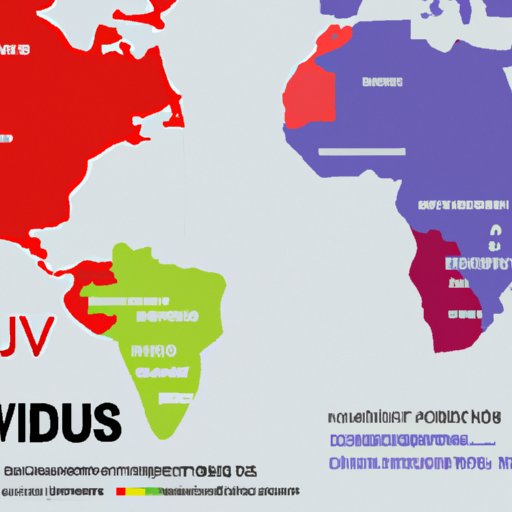Introduction
Human immunodeficiency virus (HIV) is a virus that attacks the body’s immune system, leaving it unable to fight off infections and diseases. HIV can be spread through contact with infected blood, semen, or other bodily fluids, as well as through mother-to-child transmission. If left untreated, HIV can lead to acquired immunodeficiency syndrome (AIDS), a condition which is fatal.
Despite medical advances in the prevention and treatment of HIV, the virus continues to disproportionately affect certain populations. In order to reduce the prevalence of HIV, it is important to identify those who are most at risk, as well as the underlying factors that contribute to this increased risk. This article will explore who is most at risk from HIV, examining the various demographic, social, economic, and geographic factors that contribute to HIV risk.

Examining the Demographics of HIV Risk
In order to identify those who are most at risk from HIV, it is necessary to examine the demographics of those who are infected with the virus. Globally, men account for the majority of HIV cases, making up around 60% of all infections. In terms of age, young people aged 15-24 years old are particularly vulnerable to HIV infection, accounting for 40% of new HIV infections worldwide. Additionally, HIV disproportionately affects certain sexual orientations, with gay, bisexual, and other men who have sex with men making up around 70% of all new HIV infections among adults in some countries.
Exploring the Social and Economic Factors that Contribute to HIV Risk
The risk of HIV infection is often linked to social and economic factors. Poverty and lack of access to healthcare can increase the risk of HIV, as individuals may be more likely to engage in risky behaviors such as unprotected sex or needle-sharing. Additionally, stigma and discrimination surrounding HIV can lead to a lack of awareness and education, which can further increase the risk of infection. Substance abuse can also play a role in increasing HIV risk, as those who use drugs intravenously are more likely to share needles and therefore come into contact with infected blood.
Investigating the Gender Divide in HIV Risk
Gender can also have a significant impact on HIV risk. Women are more likely to contract HIV than men, accounting for 59% of all infections in sub-Saharan Africa. This gender divide is largely due to gender-based violence and the unequal power dynamics between men and women, which can leave women vulnerable to HIV infection. Additionally, women often lack access to healthcare and face social and cultural barriers when seeking help for HIV, further exacerbating the gender gap in HIV risk.
Assessing the Role of Education in Reducing HIV Risk
Education is key to reducing the risk of HIV. Targeted campaigns that provide information about HIV prevention, testing, and treatment can help to raise awareness and encourage safer behavior. Additionally, comprehensive sex education can help to reduce the risk of HIV by equipping young people with the knowledge and skills they need to protect themselves. Education can also help to reduce the stigma and discrimination associated with HIV, creating a more supportive environment for those living with the virus.

Understanding How Race and Ethnicity Affect HIV Risk
Race and ethnicity can also influence HIV risk. In the United States, African Americans are disproportionately affected by HIV, accounting for 44% of all new infections in 2018. This disparity can be linked to structural racism and inequality, as African Americans are more likely to live in poverty and lack access to healthcare. Additionally, there is evidence that stigma and discrimination against African Americans can result in poorer HIV outcomes, such as delayed diagnosis and treatment.

Analysing the Impact of Geography on HIV Risk
Geography is another factor that can influence HIV risk. HIV prevalence varies significantly across different regions, with some countries having much higher rates of infection than others. Urbanization and migration can also contribute to HIV risk, as individuals who move to cities may lack access to healthcare and may be more likely to engage in risky behaviors. Additionally, in some countries, conflict and instability can increase the risk of HIV, as individuals may lack access to healthcare and may be more likely to engage in unsafe practices.
Conclusion
This article has explored the various factors that contribute to HIV risk, including demographics, social and economic, gender, education, race and ethnicity, and geography. It is clear that HIV disproportionately affects certain populations, such as young people, gay, bisexual, and other men who have sex with men, and African Americans. Additionally, poverty, lack of access to healthcare, stigma and discrimination, substance abuse, gender-based violence, and structural racism can all increase the risk of HIV. Education is key to reducing the risk of HIV, as well as raising awareness and reducing stigma. Finally, geography can also influence HIV risk, with some countries having much higher rates of infection than others. It is important to identify those who are most at risk from HIV in order to inform prevention strategies and reduce the prevalence of the virus.
Call to Action
It is vital that we continue to work towards reducing the prevalence of HIV. This means identifying those who are most at risk and addressing the underlying factors that contribute to HIV risk. We must ensure that those living with HIV have access to the care and support they need, and that targeted educational campaigns are implemented to raise awareness and reduce stigma. By working together, we can make progress towards ending the HIV epidemic.


